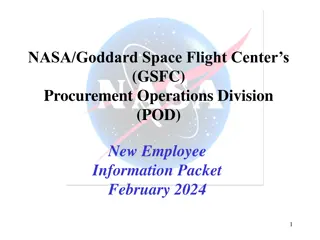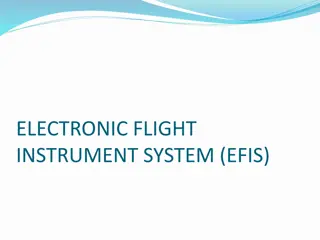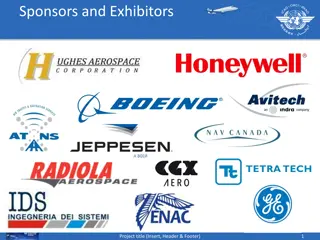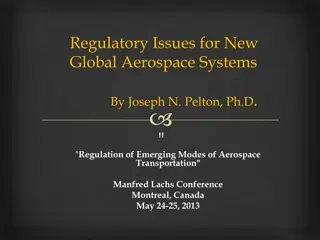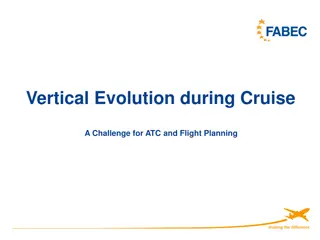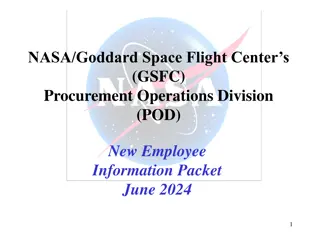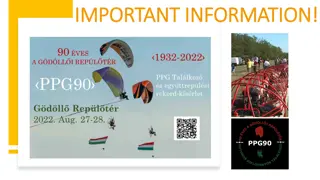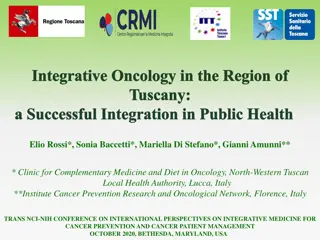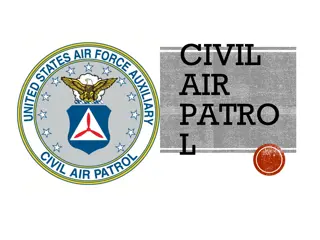Aerospace Medicine Overview - Insights into Flight and Space Health
Explore Aerospace Medicine, a specialized field addressing the healthcare needs of individuals in aviation, sea, and space environments. Learn about its unique history, practitioners, and roles in ensuring the well-being and safety of aviation and space personnel worldwide. Dive into topics such as flight environment, clinical aspects, operational considerations, and the evolution from aviation medicine to aerospace medicine.
Download Presentation

Please find below an Image/Link to download the presentation.
The content on the website is provided AS IS for your information and personal use only. It may not be sold, licensed, or shared on other websites without obtaining consent from the author. Download presentation by click this link. If you encounter any issues during the download, it is possible that the publisher has removed the file from their server.
E N D
Presentation Transcript
This is Aerospace Medicine Presented by the Aerospace Medical Association 1 of 71
Overview Introduction Flight Environment Clinical Aerospace Medicine Operational Aerospace Medicine 2 of 71
Aerospace Medicine vs. Traditional Medicine Medical Discipline Physiology Environment Traditional Medicine Abnormal Normal Aerospace Medicine Normal/Abnormal Abnormal 3 of 71
Brief History of Flight Medicine Advent of powered flight presented new physiologic demands such as altitude exposure Aviation Medicine driven by WWI high losses of life due to physically unfit pilots Development of manned space flight led to evolution of Aviation Medicine into Aerospace Medicine 4 of 71
Aerospace Medicine Practitioners Address needs of all who work, recreate, and travel in the air, sea, and space Trained in medicine, with special knowledge of operating in extreme environments of flight, undersea, and space Uniquely equipped to make decisions on selection and retention of aviators, divers, and space mission and space flight participants. 5 of 71
Aerospace Medicine Practitioners Armed Forces across the globe Crew & Passenger Health Military Safety Policy Certification & Appeals Regulatory Compliance Aeromedical Examiner training & oversight Airline Medical Departments FAA/DOT Evaluation & treatment : pathologic bubble formation Accident Investigation Aerospace Medicine Physicians Astronaut selection & training Osteo & soft tissue radionecrosis Hyperbaric Medicine Space Agencies Clinical & basic science studies Wound Infections Thermal burns Development of countermeasures Space Medical Operations Support to space agencies & commercial space ventures Longitudinal Health 6 of 71
Aerospace Medicine Practitioners International Aviation Medical Examiners European Aviation Safety Agency (EASA) Training provides an understanding of aviation related problems, physiology, standards, and administrative processes 60 hr basic and 60 hr advanced courses Aviation Medical Examiners (AMEs) Designated, trained, and supervised by the FAA Flight Surgeons Examine/certify civilian pilots Training provides an understanding of aviation related problems, physiology, standards, and administrative processes One week course with mandatory refresher courses 7 of 71
Aerospace Medicine Practitioners Military Flight Surgeons Caring for aviators and their families, manage aerospace medicine and public health programs Special training programs: Residency in Aerospace Medicine (RAM) Non-RAM military courses 8 of 71
Aerospace Medicine Practitioners National Aeronautics and Space Administration (NASA) Flight Surgeon Duties Medical care for astronaut corps and their families Astronaut selection and mission training Develops physiologic countermeasures for spaceflight Ensures crew health and safety Research promoting a better understanding of medical issues associated with spaceflight environment 9 of 71
Advanced Training in Aerospace Medicine United States Civilian Residencies University of Texas - Medical Branch Wright State University Civilian Fellowships Mayo Clinic Military Residencies US Navy US Army US Air Force United Kingdom Subspecialty of Occupational Medicine Civilian Fellowship: King s College in London Military Fellowship: Royal Air Force (RAF) Centre of Aviation Medicine 10 of 71
Aerospace Medicine Practitioners (Non-Physicians) Aerospace Experimental Psychologists Aerospace Physiologists Bioenvironmental Engineers Cognitive Psychologists Environmental Health Professionals Flight Nurses Human Factors Engineers Industrial Hygienists Radiation Health Professionals Systems Engineers 11 of 71
Advanced Training in Aerospace Medicine Other countries also have advanced training in aerospace medicine with military and civilian components 12 of 71
The Flight Environment 13 of 71
Theory of Flight Atmospheric flight Bernoulli and Newton described the concept of lift, when air flows over a wing. Space Flight Suborbital and Orbital Lunar and Interplanetary 14 of 71
The Atmosphere Composition Gases Additional Components Solid particles Dust Sea Salt Nitrogen 78 % (at SL 592.8 mmHg) Oxygen 21% (at SL 159.6 mmHg) Other 1% (at SL 76 mmHg) 15 of 71
The Atmosphere Gaseous mass surrounding Earth which is retained by the Earth s gravitational field Governed by gas laws 16 of 71
Key Atmospheric Properties in Ascent Temperature Pressure Humidity Oxygen Radiation 17 of 71
The Atmosphere Pressure: Pressure: Units of Measurement Reference Measurements At sea level, (59 F or 15 C) atmospheric pressure is: International Civil Aviation Organization (ICAO) standard atmosphere International Atmosphere US Standard Atmosphere = 760 mmHg = 29.92 inches Hg = 1013.2 millibars At 18,000 ft (5454.5m) atmospheric pressure is 380 mmHg 18 of 71
Atmospheric Pressure & Altitude 1 atmosphere pressure = 760 mmHg = sea level atmospheric pressure = 570 mmHg = 8,000 ft (2424 m) atmospheric pressure = 380 mmHg = 18,000 ft (5454.5 m) atmospheric pressure = 190 mmHg = 33,500 ft (10,151.5 m) 19 of 71
Atmosphere Biosphere Characteristic Highlights Site of the majority of aviation activity Temperature Lapse Rate Temperature Decreases until Tropopause (30,000 ft or 9144 m) at poles & 60,000 ft (18,288 m ) at equator Troposphere Contains Ozone layer, important for UV radiation protection Stratosphere Coldest sphere -110 C at 290,000 ft (85 km) Mesosphere Charged particles modified by solar flare Thermosphere Sparse particle collisions Hydrogen & Helium Edge of Space Exosphere 20 of 71
Aerospace Physiology Respiration Cardiovascular System Spatial Orientation Bioacoustics Vision Sleep and Circadian Rhythms Acceleration Gravitational Effects Vibration Hypobaria Hyperbaria Other Physical Factors Human Factors 21 of 71
Respiration: Gas Laws Pressure changes at different altitudes creates various physiologic stresses i.e., hypoxia, decompression These changes are governed by the Gas Laws such as Boyle s Law, Dalton s Law, Henry s Law Example: Body cavity volume expansion (GI tract, middle ear, and teeth) with altitude is governed by Boyle s Law 22 of 71
Respiration External Respiration (Ventilation) Internal Respiration Chemical reaction at the cellular level of carbohydrates and oxygen, producing energy as well as carbon dioxide Exchange of gases between body and atmosphere 23 of 71
Respiration: Gas Exchange Oxygen: Transported in the body via hemoglobin in the red blood cells and very little in physical solution Carbon dioxide: Transport of the waste gas mainly in solution in the blood and 5% via hemoglobin Gas exchange: Occurs at the alveolocapillary membrane (oxygen diffuses from alveolus to capillary and combines with hemoglobin, CO2 diffuses from blood into alveolus and is exhaled) 24 of 71
Respiration Hypoxic Hypoxia Hypemic Hypoxia Oxygen deficiency from reduced oxygen carrying capacity in the blood Oxygen deficiency from ineffective gas exchange at lung or inadequate oxygen inspiration Causes of Hypoxia Histotoxic Hypoxia Oxygen deficiency from inability to use oxygen at the molecular level Stagnant Hypoxia Oxygen deficiency from inadequate delivery of blood flow. 25 of 71
Hypobaria Altitude (feet/meters) Effective Performance Time 20-30 min Increased Danger of Hypoxia 18,000/6,000 High Altitude Low Pressure Low Partial Pressure O2 25,000/8,333 3-5 min Insidious onset makes hypoxia a real danger in high altitude flight. 35,000/11,666 1 min 30 secs 50,000/16,666 9-12 secs 26 of 71
Hypobaria: Decompression Sickness Altitude Decompression Sickness (DCS) Ascent Decompression Barometric Pressure (PB) Decrease Subset of Decompression Illness (DCI) DCI includes: Arterial Gas Embolism (AGE) Ebullism Trapped gas Result of decompression in accordance with Henry s Gas Law . Not all bubble formation with decompression leads to DCS. Supersaturation PN2 > PB Pathologic (Nitrogen) Bubble Formation DCS 27 of 71
Hypobaria: Symptoms of Altitude DCS Limb pain: at least 70% of all symptoms Most common presentation Typically joint or muscle pain Neurologic:about 1-8% of all symptoms Cold sweat, dizziness, edema, inappropriate or sudden onset of fatigue, headache, light headedness, loss of consciousness, motor and/or sensory loss, nausea, tremor (shakes), vertigo Pulmonary: about 3% of all symptoms Cough, dyspnea (difficult or labored breathing), substernal distress (tightness and/or pain in chest, especially during inspiration); sometimes called Chokes Skin symptoms: about 13% of all symptoms Mottling, pins & needles, tingling, prickling 28 of 71
Altitude Hypobaria: Treatment of DCS Immediate treatment in the aircraft 100% oxygen (until told to stop by qualified physician) Descend as soon as practical Declare In-Flight Emergency (IFE) Land at the nearest airfield with qualified medical assistance available Symptoms may resolve during descent ! Symptoms may resolve during descent ! After landing Hyperbaric Oxygen Therapy (HBOT): compresses bubbles, increasing circulation, and provides more O2 to tissues Specialty care for serious DCS symptoms (respiratory or neurologic) or those which do not resolve during descent/repressurization; possible neurologic consult 29 of 71
Hypobaria: Protection from DCS Adequately pressurized cabin Denitrogenation by preoxygenation Pre-Breathing 100% oxygen to off-gas nitrogen Before decompression Same value, if done below 16,000 ft 30 of 71
Acceleration, Inertial Forces & Cardiovascular System CO = MAP/ TPR Represents the ability of the system to provide adequate blood flow Accelerative stress challenges the CV system s ability to maintain blood flow to all vital organs, especially the brain Accelerative forces may also impede venous blood return to the heart Goal: Adequate End Organ Perfusion -Gz +Gx +Gy -Gy -Gx +Gz 31 of 71
Acceleration Effects High Performance Aircraft G-induced Loss Of Consciousness (G-LOC): state of unconsciousness when the G-forces reduce blood flow to the brain below the critical level Push Pull Effect: Decreased +Gz tolerance resulting from preceding relative -Gz 32 of 71
Acceleration Human Tolerance to +Gz Long duration ( >1 sec) + 2 Gz Compression into seat Movement Difficult + 3 Gz Extreme heaviness of limbs and body Impossible to move or escape from aircraft Greater than +3 Gz Dimming or graying of vision, and possible G-LOC Short duration (<1 sec) Up to +40 Gz depending on body position 33 of 71
Space Flight Effects Microgravity affects blood and interstitial fluid flow (approximately 1-2 liters shift towards the head and torso) Bone demineralization leads to increased loss of calcium in urine and increased risk of kidney stones Muscle mass reduction Space motion sickness Radiation exposure Decreased immune system function Psychology/Human factors 34 of 71
Spatial Orientation Visual (most important), vestibular, somatosensory (seat-of the-pants), and auditory systems Easily confused when moving in 3 planes of motion (pitch, yaw, and roll) Disorientation is a leading contributor to many fatal aircraft accidents 35 of 71
Vision Vision is a key factor for spatial orientation in flight Errors may occur in visual perception Color vision deficiencies can affect up to 8% of men and 2% of women. Identifying these deficiencies is becoming more important as aircraft and air traffic control displays utilize colors and visual cues to display critical information. 36 of 71
Bioacoustics Noise in aviation can be detrimental to hearing & communication dBA 20 50-70 100-110 130 140-160 167 Sound Whisper at 5 ft. Normal Conversation Power Lawn Mower Pain Threshold for Humans Jet Engine Saturn V Rocket 37 of 71
Vibration Vibration is oscillatory motion in dynamic systems Human body most sensitive to vibration in vertical direction Vibration affects a variety of body systems General discomfort at 4.5-9 cycles per second (cps) Abdominal pain at 4.5-10 cps Lumbosacral pain at 8-12 cps Head sensations at 13-20 cps 38 of 71
Other Physical Factors Associated with Flying Thermal Extreme temperature swings in aviation (e.g. hot in cockpit on tarmac & freezing cold at altitude) Radiation Air travel at high altitudes Risk for commercial aviation and spaceflight crews Toxicology Importance of knowledge of toxins in aviation (jet fuels, release of toxic fumes in fires, alcohol in blood versus vitreous, etc.) 39 of 71
Human Factors By definition, Human Factors is the impact of human behavior, abilities, limitations, and other characteristics to the design of tools, machines, systems, tasks, jobs, and environments for productive, safe, comfortable, and effective human use. The goal of Human Factors is to apply knowledge in designing systems that work, accommodating the limits of human performance. 40 of 71
Human Factors Human-Machine Interface Human Error implicated in 60-80% of accidents in complex, high technology systems Task and information overload is critical issue Science of color, size, position of switches/knobs, etc. and relevance to mission drive design 41 of 71
Human Factors Sleep & Circadian Rhythms Internal body clock shifts with travel and work schedule and may impairs performance Need to plan crew work-rest cycles to avoid accidents 42 of 71
Life Support Systems Oxygen Systems Dilutor Demand Flow of oxygen proportional to cabin altitude [100% oxygen at 33,000 ft (10,058 m)] Pressure Demand Oxygen supplied with slight overpressure > 10,000 ft to full pressure breathing > 38,000 ft (11,582 m) UK: >40,000 ft (12,192 m) Pressure Demand with Regulator Mounted on panel, seat or mask Regulator attached to mask directly or via hose Continuous Flow Passenger system, exhaled air collected in bag to economize oxygen use May be chemically generated for short term emergency use 43 of 71
Cabin Air Quality Temperature Ozone Carbon Dioxide Humidity Oxygen Bioaerosols Cabin Air Quality Factors Pressure Tobacco 44 of 71
Cabin Air Quality Relative Humidity At altitude in cabin ~ 6-10%, flight deck ~ 3% Due to very dry ambient air at altitude Air conditioned air entering AC cabin has relative humidity < 1% Irritation of eyes / sense of dry mucous membranes Plasma osmolality maintained by homeostatic renal function Air Recirculation Complete air exchange every 3-4 min (homes q 12 min) Up to 30-50% High efficiency particulate air filter filtration (efficient to 0.3 micrometers) Carbon Dioxide 0.5 % by volume (sea level equivalent) 45 of 71
Life Support Systems Airline Medical Systems Minimize risks to passengers Avoid unscheduled diversions Onboard emergency medical capabilities are limited (airline medical kits) Communication with ground support from internal airline medical staff or contracted staff Passengers requiring medical oxygen must make separate arrangements with the airline Cockpit emergency oxygen is via a compressed oxygen system and is separate from passenger emergency oxygen Emergency oxygen: 10-20 minute supply for passengers produced with chemical oxygen generators Limited number of walk- around bottles for crew 46 of 71
Clinical Aerospace Medicine 47 of 71
Fitness for Duty & Return to Flight Status Screen aviators, astronauts, air traffic control personnel for risk of sudden incapacitation or degradation in skills Applies to all areas of medicine Applies to all types of aviators, i.e. military, commercial pilots, private pilots, and flight crew 48 of 71
Fitness for Duty & Return to Flight Status Medical Standards Civilian standards (i.e. FAA, NASA, EASA) and military standards (Air Force, Navy, Army) may differ due to different aircraft, mission requirements, and operating environments. Examples include: Type of aircraft - Multi-crew Aircraft vs. Single Seat Fighter Jet Type of Operation/Environment Recreational vs. Airline Transport Operations Wartime, Remote environments Initial selection vs. Maintenance of Standard 49 of 71
Fitness for Duty & Return to Flight Status: Multisystem Approach Cardiology Pulmonology Ophthalmology Otolaryngology Psychiatry and Psychology Neurology Other Conditions 50 of 71
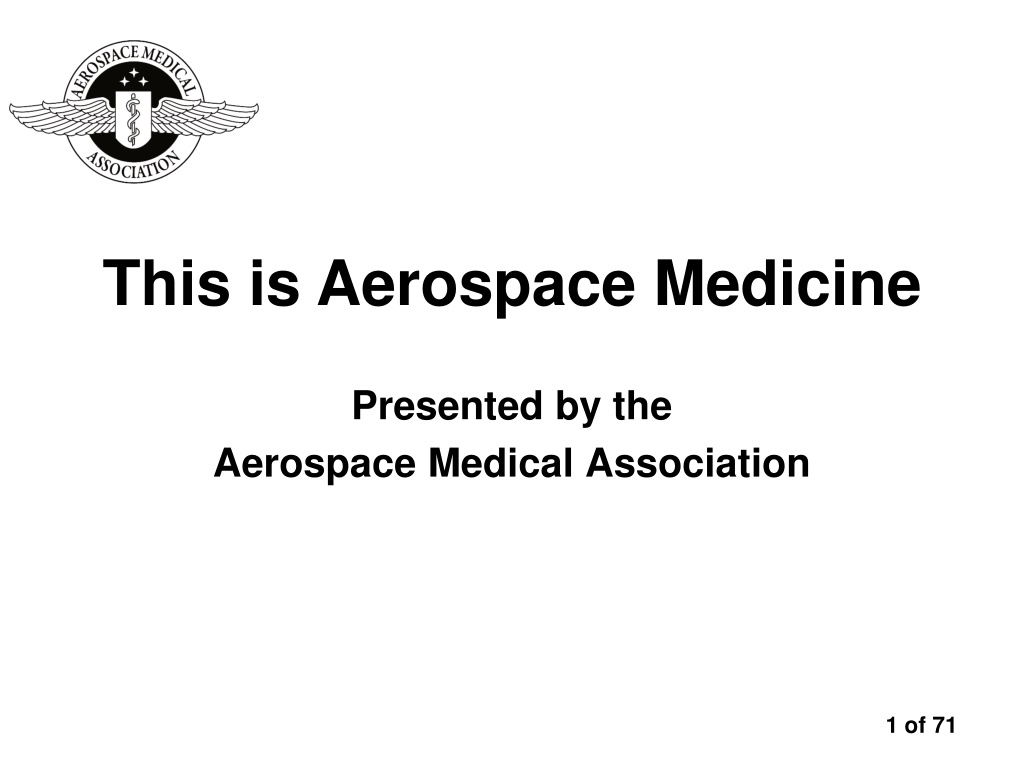



![❤[READ]❤ Deep Space Craft: An Overview of Interplanetary Flight (Springer Praxis](/thumb/21511/read-deep-space-craft-an-overview-of-interplanetary-flight-springer-praxis.jpg)



